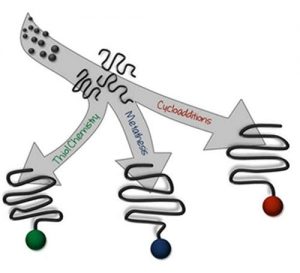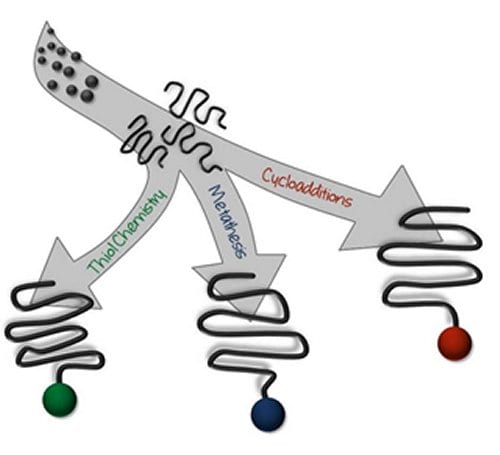 Advanced applications of polymers in material science and their employment in subsequent modular construction efforts require efficient post-transformation protocols. The firm establishment of advanced living/controlled polymerization techniques allows for the generation of extremely well–defined polymer architectures from a wide monomer range under mild conditions. These protocols form the basis for the subsequent polymer modification.
Advanced applications of polymers in material science and their employment in subsequent modular construction efforts require efficient post-transformation protocols. The firm establishment of advanced living/controlled polymerization techniques allows for the generation of extremely well–defined polymer architectures from a wide monomer range under mild conditions. These protocols form the basis for the subsequent polymer modification.
The group of Barner-Kowollik at the Karlsruhe Institute of Technology (KIT) highlights the current status of selected post-functionalization techniques of polymers via orthogonal ligation chemistries, collating the key information regarding the synthetic process, the reaction conditions required as well as characterization data that evidences a successful transformation in an encompassing tabular format: A true users’ guide to polymer post-modification is provided! Many of the chemistries collated in the tables have been selected for their transformational power. The selection presented in the review article is a critical one, implying that not every possible transformation is listed, but only those which have been judged to be most useful in a synthetic context, i.e. feature high conversions, mild conditions and readily removable by–products. In terms of the chemical scope, the focus is on cycloaddition reactions, thiol–X chemistry, oxime transformations, metathesis reactions, i.e. ring–opening metathesis polymerization (ROMP) and acyclic diene metathesis (ADMET), as well as Pd–catalyzed coupling reactions.
This review article is an excellent source for all researchers interested in polymer post-modification. Read it now for free for a limited time!

















